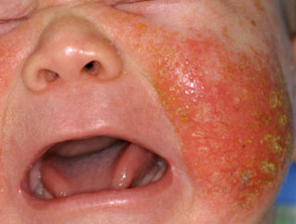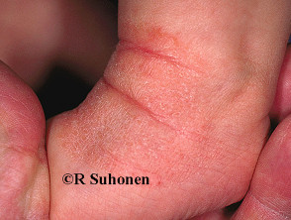Eczema, Atopic:
- Atopic eczema is a genetic disorder, with environmental influences.
- Its prevalence in children is approximately 20%.
- It is not curable but is treatable and this difference is important to discuss with carers.
- Itch is the principal symptom and can cause sleep disturbance and difficulty concentrating.
- In the great majority of children with mild to moderate eczema that responds to topical treatment food allergy is not a significant contributing factor
 |  |  |
| Infantile Eczema Search DermNet | DermNet (dermnetnz.org) | Infected Eczema– Search DermNet | DermNet (dermnetnz.org) | Chronic Eczema – Search DermNet | DermNet (dermnetnz.org) |
Who to refer:
- Diagnosis is or becomes uncertain.
- Eczema is not controlled despite following the advice on the Primary Care Management tab.
- Erythrodermic eczema (involving > 80-90% of skin surface area).
- Eczema herpeticum (an acute, painful, blistering flare of eczema) is suspected – discuss with on-call dermatologist immediately for advice.
- Eczema causing severe psychological or social difficulties.
- Recurrent infection
Important considerations in managing atopic eczema:
- It is a chronic condition characterised by flares and remissions: it keeps coming back! It is important to give carers the skills to manage flares.
- It can have a very significant negative impact on quality of life, not only for the patient but also the family.
- It is frequently undertreated because of:
- fear of causing harm and skin damage from the use of topical corticosteroids
- the basic management of eczema (the application of topicals and dressings) is time consuming
- consequent lack of compliance (“treatment fatigue”)
- Some parents/carers are unduly focussed on the possibility that allergy is the underlying cause of their child’s eczema.
Assessment of the child with eczema:
- How extensive is the eczema?
- How is it affecting the child and their family in their daily lives (e.g. disturbing sleep, schooling, and mental wellbeing)?
- Are there exacerbating factors that can easily be addressed, such as soap, shampoo or bubble bath use?
- Are there any barriers to the child being treated effectively?
- Is the eczema excoriated?
- Is there associated bacterial infection (crusting, weeping areas or impetigo), herpes simplex infection or scabies?
Emollients:
- Emollients are essential for successfully treating eczema.
- Ointments are generally preferable to creams, unless the patient or carer dislikes the greasiness.
- Most emollients can be used both as a leave-on moisturiser (except aqueous cream) or soap substitute (apart from 50:50 white soft paraffin/liquid paraffin).
- Emollients should be applied liberally and frequently (up to 3-4 times a day is reasonable).
- Provide adequate quantities: eg 500g-1kg per week for older children and 250-500g per week for younger children.
- There are different degrees of greasiness.
- Examples of greasy emollients (ointments): 50:50 WSP/LP, Hydromol®,
- Examples of medium greasiness (creams): Zerobase®, Zerodouble®
- Example of mild greasiness (cream): Zeroveen®
- The choice of emollient should be guided by patient & carer preference and ease of use.
- Apply emollients in a thin layer and in the direction of hair growth to avoid folliculitis.
- Recommend use of a clean spoon/spatula to scoop ointments from tub (to prevent bacterial contamination).
- Discourage bath emollients (lack of evidence base, can cause accidents).
- Warn about flammability (with both emollients and other topical agents) especially when emollients soak into clothing or bandages.
- Soaps, shampoo, shower gels and bubble baths (even ‘gentle’ formulations) are irritant – they contribute to dry itchy skin and should be avoided. Use a soap substitute instead
Antimicrobials:
- If eczema appears infected (ie weeping or crusted/scabby), consider a short course (5-7 days) of an appropriate oral antibiotic. If not improving or recurrent infection then take a swab for microbiology.
- Additionally, consider an antiseptic in bath or shower – Milton® baths (see Resources), Dermol® range, Oilatum Plus®
Topical Steroids:
- Provide information leaflet (see Resource Section).
- Reassure patients that topical steroids are safe and effective if used as prescribed– the correct potency for the body region for the correct length of time.
- Prescribe in ointment form if acceptable to child and carers.
- Once daily application (after bathing).
- Apply a thin layer, just enough to produce a shine on treated skin, or advise on fingertip units (see Resource tab below).
- Face – initially use a mild steroid ointment (hydrocortisone 1%), daily for up to 7-10 days. If no improvement, increase to a moderately potent steroid ointment such as clobetasone butyrate daily for up to 7-10 days.
- Avoid steroid ointment getting directly into the eye.
- Trunk and limbs – initially use a moderately potent steroid ointment such as clobetasone butyrate daily for up to 2-3 weeks. In children > 1year old, if no improvement after 1 week, this can be stepped up to a potent steroid ointment such as mometasone furoate or betamethasone valerate 0.1%, daily for up to 10-14 days.
- Step down to a moderate or mild steroid when eczema is controlled, before stopping (this reduces the risk of an immediate flare-up)
- Courses of topical steroid can be repeated when flares occur.
- Review the amount of steroid prescribed at least twice a year.
Topical calcineurin inhibitors:
- Provide information leaflet (see Resources section).
- They can be initiated in primary care if the GP is comfortable to do so, where eczema is uncomplicated, moderate to severe in degree, and topical corticosteroid usage has not given sustained benefit or is considered likely to cause adverse effects. Please seek advice from the department if you would like support with initiating this treatment.
- Tacrolimus 0.03% ointment is licensed for treatment of moderate to severe eczema in children> 2 years
- Pimecrolimus cream is licensed for treatment of mild to moderate eczema in children> 2 years
- Apply to areas of active eczema twice daily for up to 3 weeks, and then once daily thereafter if eczema still active.
- Apply a line layer, just enough to produce a shine on treated skin.
- Caveats:
- Do not apply to skin that is infected
- Sun-protect treated areas
- Warn patients and carers that it may sting on initial application, but that this tends to diminish over 3-4 days with continued use.
- Their use in children < 2 years old is off-licence
- Review the amount prescribed at least twice a year
- Review child every 2-3 months
Maintenance Therapy:
- In order to reduce the frequency of eczema flares, topical steroids and calcineurin inhibitors can be used on a long-term twice weekly basis to eczema-prone areas (whether inflamed or not) – to help prevent recurrence.
- Topical steroids: once daily application of clobetasone butyrate ointment on two consecutive days each week (for instance, Saturdays and Sundays) for up to 4-6 months; if a flare develops, resume daily treatment for 1-2 weeks.
- Calcineurin inhibitors: once daily application of tacrolimus 0.03% ointment on two days each week (for instance, Mondays and Thursdays) for up to 4-6 months; if a flare develops, resume twice daily treatment for 1-2 weeks.
Dressings:
- An occlusive dressing will usually enhance the efficacy of emollients and topical corticosteroids, and may help to protect against excoriation – but some children do not like the feel of a dressing and this can sometimes worsen discomfort and increase scratching.
- Not recommended for use with topical calcineurin inhibitors.
- Not recommended when eczema is infected, weeping or sticky.
- Prescribe at least 2 sets of tubular garments & gloves of appropriate size e.g. Comfifast®, Clinifast®, Skinnies®
- A simple regime for overnight or all-day use is:
50:50 WSP/LP
clobetasone butyrate (Eumovate®) ointment
tubular garment
- If this simple regime is ineffective:
50:50 white soft paraffin/liquid paraffin
clobetasone butyrate (Eumovate®) ointment
1% ichthammol/15% zinc oxide in yellow soft paraffin (found
under “Specials” on prescribing tab on Vision and can be
mixed with 50:50 WSP/LP to facilitate its application)
a tubular garment
Antihistamines:
- Short term use of a sedating antihistamine (such as chlorphenamine) at night may help reduce sleep disturbance.
For Patients
Support Groups
National Eczema Society: www.eczema.org
Eczema Outreach Support: http://www.eos.org.uk/
Information
British association of Dermatologists’ patient information leaflets:
Atopic eczema
http://www.bad.org.uk/shared/get-file.ashx?id=69&itemtype=document
Topical Steroids
https://www.bad.org.uk/shared/get-file.ashx?id=183&itemtype=document
Calcineurin inhibitors
British Association of Dermatologists (bad.org.uk)
Bleach bath
Bleach-Baths-A-treatment-for-infected-eczema-1.pdf (scot.nhs.uk)
For Health Professionals
SIGN guideline – https://www.sign.ac.uk/assets/sign125.pdf
NICE CKS – https://cks.nice.org.uk/eczema-atopic
PCDS guidance on Atopic Eczema clinical-guidance/atopic-eczema
Finger Tip Units – information can be found on CKS site (above) and at
https://www.nhs.uk/conditions/topical-steroids/
PCDS link to video of how to apply wet wraps & dry wraps
http://www.pcds.org.uk/p/wet-wraps-and-dry-wraps
Patient Action Plan – http://www.bristol.ac.uk/primaryhealthcare/researchthemes/apache/ewap/













